Blog
Signs and Symptoms of Poor Circulation in Feet
Cold feet and hands, in addition to swelling and cramping, may often be symptoms of poor circulation. Many times it can be a sign of other health issues, such as high blood pressure and diabetes. Red or blue toes, tingling in the feet, and unexpected hair loss on the legs may all point to circulation issues. Veins can be damaged, which can then restrict or even stop blood flow and possibly lead to blood clots in the leg. Typically, unhealthy behaviors are contributing factors, and learning to manage them is a good starting point in controlling poor circulation. These may include smoking cigarettes, lack of exercise, or having high cholesterol and blood pressure. Occasionally, using leg massagers may help to stimulate circulation which improves blood flow. Additionally, wearing support hosiery and proper footwear may help your feet to feel better by improving circulation.
Poor circulation is a serious condition and needs immediate medical attention. If you have any concerns with poor circulation in your feet contact one of our podiatrists of Westside Podiatry Center, LLP. Our doctors will treat your foot and ankle needs.
Poor Circulation in the Feet
Poor blood circulation in the feet and legs is can be caused by peripheral artery disease (PAD), which is the result of a buildup of plaque in the arteries.
Plaque buildup or atherosclerosis results from excess calcium and cholesterol in the bloodstream. This can restrict the amount of blood which can flow through the arteries. Poor blood circulation in the feet and legs are sometimes caused by inflammation in the blood vessels, known as vasculitis.
Causes
Lack of oxygen and oxygen from poor blood circulation restricts muscle growth and development. It can also cause:
- Muscle pain, stiffness, or weakness
- Numbness or cramping in the legs
- Skin discoloration
- Slower nail & hair growth
- Erectile dysfunction
Those who have diabetes or smoke are at greatest risk for poor circulation, as are those who are over 50. If you have poor circulation in the feet and legs it may be caused by PAD and is important to make changes to your lifestyle in order to reduce risk of getting a heart attack or stroke. Exercise and maintaining a healthy lifestyle will dramatically improve conditions.
As always, see a podiatrist as he or she will assist in finding a regimen that suits you. A podiatrist can also prescribe you any needed medication.
If you have any questions please feel free to contact one of our offices located in Liverpool, Camillus, Skaneateles, Oswego, and Cicero, NY . We offer the newest diagnostic and treatment technologies for all your foot and ankle needs.
Read more about Causes, Symptoms, and Treatment of Poor Blood Circulation in the FeetTreatments for Sweaty Feet
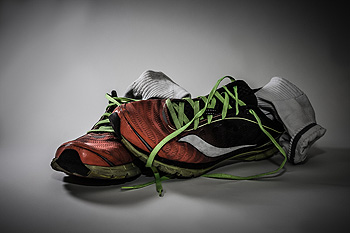 Sweaty feet is a common condition that most people find uncomfortable, and it’s often associated with an unpleasant odor in addition to a soggy feeling in the shoes and socks. Wet feet often lead to problems such as fungal infections, usually stemming from bacteria that live in warm and moist areas. Synthetic shoes socks may possibly make this condition worse, so it’s advised to wear cotton socks and leather shoes or sandals. It’s important to change your socks often and walking barefoot whenever possible may also help allow your feet to breathe. Please consult with a podiatrist if you have questions about hyperhidrosis of the feet.
Sweaty feet is a common condition that most people find uncomfortable, and it’s often associated with an unpleasant odor in addition to a soggy feeling in the shoes and socks. Wet feet often lead to problems such as fungal infections, usually stemming from bacteria that live in warm and moist areas. Synthetic shoes socks may possibly make this condition worse, so it’s advised to wear cotton socks and leather shoes or sandals. It’s important to change your socks often and walking barefoot whenever possible may also help allow your feet to breathe. Please consult with a podiatrist if you have questions about hyperhidrosis of the feet.
If you are suffering from hyperhidrosis contact one of our podiatrists of Westside Podiatry Center, LLP. Our doctors can provide the care you need to attend to all of your foot and ankle needs.
Hyperhidrosis of the Feet
Hyperhidrosis is a rare disorder that can cause people to have excessive sweating of their feet. This can usually occur all on its own without rigorous activity involved. People who suffer from hyperhidrosis may also experience sweaty palms.
Although it is said that sweating is a healthy process meant to cool down the body temperature and to maintain a proper internal temperature, hyperhidrosis may prove to be a huge hindrance on a person’s everyday life.
Plantar hyperhidrosis is considered to be the main form of hyperhidrosis. Secondary hyperhidrosis can refer to sweating that occurs in areas other than the feet or hands and armpits. Often this may be a sign of it being related to another medical condition such as menopause, hyperthyroidism and even Parkinson’s disease.
In order to alleviate this condition, it is important to see your doctor so that they may prescribe the necessary medications so that you can begin to live a normal life again. If this is left untreated, it is said that it will persist throughout an individual’s life.
A last resort approach would be surgery, but it is best to speak with your doctor to find out what may be the best treatment for you.
If you have any questions please feel free to contact one of our offices located in Liverpool, Camillus, Skaneateles, Oswego, and Cicero, NY . We offer the newest diagnostic and treatment technologies for all your foot and ankle needs.
Read more about Hyperhidrosis of the FeetHow to Deal with Corns and Calluses
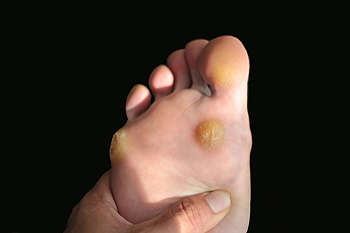 Corns and calluses are areas where the skin has hardened, generally due to friction and pressure. This friction usually stems from footwear and socks; to help prevent them from forming, wear shoes that have enough room for your feet and aren’t cramped. Over-the-counter chemical peels can remove either corns or calluses at the risk of potentially damaging skin. Pumice stones can be used to remove corns and calluses but can also damage skin. If you are a diabetic, do not attempt to remove either one and instead see a podiatrist. Overall, podiatrists can treat corns and calluses in ways that do not risk harm to your feet.
Corns and calluses are areas where the skin has hardened, generally due to friction and pressure. This friction usually stems from footwear and socks; to help prevent them from forming, wear shoes that have enough room for your feet and aren’t cramped. Over-the-counter chemical peels can remove either corns or calluses at the risk of potentially damaging skin. Pumice stones can be used to remove corns and calluses but can also damage skin. If you are a diabetic, do not attempt to remove either one and instead see a podiatrist. Overall, podiatrists can treat corns and calluses in ways that do not risk harm to your feet.
If you have any concerns regarding your feet and ankles, contact one of our podiatrists of Westside Podiatry Center, LLP. Our doctors will treat your foot and ankle needs.
Corns: What Are They? and How Do You Get Rid of Them?
Corns can be described as areas of the skin that have thickened to the point of becoming painful or irritating. They are often layers and layers of the skin that have become dry and rough, and are normally smaller than calluses.
Ways to Prevent Corns
There are many ways to get rid of painful corns such as wearing:
- Well-fitting socks
- Comfortable shoes that are not tight around your foot
- Shoes that offer support
Treating Corns
Treatment of corns involves removing the dead skin that has built up in the specific area of the foot. Consult with Our doctors to determine the best treatment option for your case of corns.
If you have any questions please feel free to contact one of our offices located in Liverpool, Camillus, Skaneateles, Oswego, and Cicero, NY . We offer the newest diagnostic and treatment technologies for all your foot and ankle needs.
Read more about Corns: What Are They, and How Do You Get Rid of ThemBlisters and Diabetic Foot Care
 Diabetics need to take proper care of their feet due to their condition. Diabetes often causes poor blood circulation and neuropathy, which causes sensation loss in the extremities and lower limbs. If a diabetic gets a blister on his or her foot, he or she may not even realize it exists. If left unchecked, a blister can become infected and potentially infect the rest of the foot; in worst cases, this may then require amputation. Prevention is key, so wearing well-fitted shoes, conducting everyday foot exams, maintaining proper foot care, and visiting a podiatrist every several months can all help prevent a foot ulcer. If you have a foot ulcer and are diabetic, it is recommended that you see a podiatrist who can provide proper care and attention to the wound.
Diabetics need to take proper care of their feet due to their condition. Diabetes often causes poor blood circulation and neuropathy, which causes sensation loss in the extremities and lower limbs. If a diabetic gets a blister on his or her foot, he or she may not even realize it exists. If left unchecked, a blister can become infected and potentially infect the rest of the foot; in worst cases, this may then require amputation. Prevention is key, so wearing well-fitted shoes, conducting everyday foot exams, maintaining proper foot care, and visiting a podiatrist every several months can all help prevent a foot ulcer. If you have a foot ulcer and are diabetic, it is recommended that you see a podiatrist who can provide proper care and attention to the wound.
Blisters are prone to making everyday activities extremely uncomfortable. If your feet are hurting, contact one of our podiatrists of Westside Podiatry Center, LLP. Our doctors can provide the care you need to keep you pain-free and on your feet.
Foot Blisters
Foot blisters develop as a result of constantly wearing tight or ill-fitting footwear. This happens due to the constant rubbing from the shoe, which can often lead to pain.
What Are Foot Blisters?
A foot blister is a small fluid-filled pocket that forms on the upper-most layer of the skin. Blisters are filled with clear fluid and can lead to blood drainage or pus if the area becomes infected.
How Do Blisters Form?
Blisters on the feet are often the result of constant friction of skin and material, usually by shoe rubbing. Walking in sandals, boots, or shoes that don’t fit properly for long periods of time can result in a blister. Having consistent foot moisture and humidity can easily lead to blister formation.
Prevention & Treatment
It is important to properly care for the affected area in order to prevent infection and ease the pain. Do not lance the blister and use a Band-Aid to provide pain relief. Also, be sure to keep your feet dry and wear proper fitting shoes. If you see blood or pus in a blister, seek assistance from a podiatrist.
If you have any questions, please feel free to contact one of our offices located in Liverpool, Camillus, Skaneateles, Oswego, and Cicero, NY . We offer the newest diagnostic and treatment technologies for all your foot care needs.
Read more about Blisters on the FeetQB Tom Brady Has an Achilles Tendon Injury
 Star quarterback Tom Brady of the New England Patriots was left on the sidelines of a practice due to an Achilles tendon injury. The injury was reported by the team and also led Brady to sit out the previous practice as well. However, he still played in the Patriots and Miami Dolphins game in which the Pats won 35 to 17. Brady went on to throw four touchdowns that day, so regardless of how severe the injury actually is, it didn’t seem to stop him from performing.
Star quarterback Tom Brady of the New England Patriots was left on the sidelines of a practice due to an Achilles tendon injury. The injury was reported by the team and also led Brady to sit out the previous practice as well. However, he still played in the Patriots and Miami Dolphins game in which the Pats won 35 to 17. Brady went on to throw four touchdowns that day, so regardless of how severe the injury actually is, it didn’t seem to stop him from performing.
Sports related foot and ankle injuries require proper treatment before players can go back to their regular routines. For more information, contact one of our podiatrists of Westside Podiatry Center, LLP. Our doctors can provide the care you need to keep you pain-free and on your feet.
Sports Related Foot and Ankle Injuries
Foot and ankle injuries are a common occurrence when it comes to athletes of any sport. While many athletes dismiss the initial aches and pains, the truth is that ignoring potential foot and ankle injuries can lead to serious problems. As athletes continue to place pressure and strain the area further, a mild injury can turn into something as serious as a rupture and may lead to a permanent disability. There are many factors that contribute to sports related foot and ankle injuries, which include failure to warm up properly, not providing support or wearing bad footwear. Common injuries and conditions athletes face, including:
- Plantar Fasciitis
- Plantar Fasciosis
- Achilles Tendinitis
- Achilles Tendon Rupture
- Ankle Sprains
Sports related injuries are commonly treated using the RICE method. This includes rest, applying ice to the injured area, compression and elevating the ankle. More serious sprains and injuries may require surgery, which could include arthroscopic and reconstructive surgery. Rehabilitation and therapy may also be required in order to get any recovering athlete to become fully functional again. Any unusual aches and pains an athlete sustains must be evaluated by a licensed, reputable medical professional.
If you have any questions please feel free to contact one of our offices located in Liverpool, Camillus, Skaneateles, Oswego, and Cicero, NY . We offer the newest diagnostic and treatment technologies for all your foot and ankle needs.
Read more about Sports Related Foot And Ankle InjuriesFoot Related Conditions Caused by Obesity
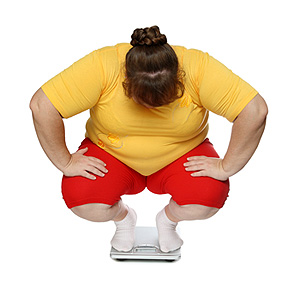 There are a number of health conditions that are affiliated with obesity. Swollen feet and varicose veins are common in obese people. Additionally, painful conditions such as cracked heels can also occur from obesity due to excessive pressure on the area. Obesity generally also contributes to diabetes, which can affect the nerves in the feet. Subsequently, patients are often unable to feel cuts or blisters, which may lead to foot ulcers. Poor balance may occur as a result of strained walking, which typically leads to falls and injury. Additionally, flat feet can develop, which may lead to conditions like plantar fasciitis. Following a healthy diet that is low in sugar may help control obesity. Maintaining a regular exercise program will aid in keeping obesity under control. Typically, obesity leads to feet that are wider than average, so look for shoes that fit properly. A podiatrist can conduct a foot examination and provide tips on obesity and how it affects the feet.
There are a number of health conditions that are affiliated with obesity. Swollen feet and varicose veins are common in obese people. Additionally, painful conditions such as cracked heels can also occur from obesity due to excessive pressure on the area. Obesity generally also contributes to diabetes, which can affect the nerves in the feet. Subsequently, patients are often unable to feel cuts or blisters, which may lead to foot ulcers. Poor balance may occur as a result of strained walking, which typically leads to falls and injury. Additionally, flat feet can develop, which may lead to conditions like plantar fasciitis. Following a healthy diet that is low in sugar may help control obesity. Maintaining a regular exercise program will aid in keeping obesity under control. Typically, obesity leads to feet that are wider than average, so look for shoes that fit properly. A podiatrist can conduct a foot examination and provide tips on obesity and how it affects the feet.
Obesity has become very problematic at this point in time and can have extremely negative effects on the feet. If you’re an obese individual and are concerned about your feet, contact one of our podiatrists from Westside Podiatry Center, LLP. Our doctors can provide the care you need to keep you pain-free and on your feet.
Obesity and Your Feet
Since your feet are what support your entire weight when standing, any additional weight can result in pain and swelling. Being overweight is one of the main contributors to foot complications.
Problems & Complications
Extra Weight – Even putting on just a few extra pounds could create serious complications for your feet. As your weight increases, your balance and body will shift, creating new stresses on your feet. This uneven weight distribution can cause pain, even while doing the simplest tasks, such as walking.
Diabetes – People who are overweight are at serious risk of developing type-2 diabetes, which has a drastic impact on the health of your feet. As you get older, your diabetes might worsen, which could lead to loss of feeling in your feet, sores, and bruises. You could also become more prone to various infections.
Plantar fasciitis – Pressure and stress that is placed on muscles, joints, and tendons can trigger plantar fasciitis, which is an inflammation of tissue that forms along the bottom of the foot.
If you have any questions please feel free to contact one of our offices located in Liverpool, Camillus, Skaneateles, Oswego, and Cicero, NY . We offer the newest diagnostic and treatment technologies for all your foot and ankle needs.
Read more about How Obesity Affects Your FeetHow PRP Injections Can Help the Healing Process
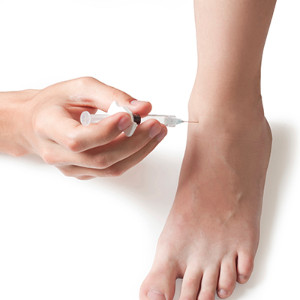 Platelet Rich Plasma Therapy, also known as PRP injections, is a non-surgical treatment that helps the body to naturally heal itself. Platelets, or small blood cells, contain hormones which can accelerate growth and healing, in addition to their other purpose of clotting damaged blood vessels. Diabetics, who may experience foot ulcers that heal too slowly, may benefit from PRP injections; PRP injections can aid in the improvement of tissue rejuvenation, which may jump-start the healing process. It may also be successful in treating plantar fasciitis, as it contains high concentrations of platelets abundant with growth and healing factors. Please consult with a podiatrist to learn more about PRP injections.
Platelet Rich Plasma Therapy, also known as PRP injections, is a non-surgical treatment that helps the body to naturally heal itself. Platelets, or small blood cells, contain hormones which can accelerate growth and healing, in addition to their other purpose of clotting damaged blood vessels. Diabetics, who may experience foot ulcers that heal too slowly, may benefit from PRP injections; PRP injections can aid in the improvement of tissue rejuvenation, which may jump-start the healing process. It may also be successful in treating plantar fasciitis, as it contains high concentrations of platelets abundant with growth and healing factors. Please consult with a podiatrist to learn more about PRP injections.
If you are suffering from a foot condition, contact one of our podiatrists of Westside Podiatry Center, LLP. Our doctors will assist you with all of your podiatric concerns.
What Is PRP?
Platelet Rich Plasma, or PRP, is blood taken from a patient and spun in a centrifuge, concentrating the amount of platelets. The plasma is then re-injected into the site of injury or damage, assisting the body in repairing damage to muscles, tendons, ligaments, and tissue. PRP helps the body speed up its healing process.
Uses of PRP
Injuries affecting the foot sometimes don’t heal properly because of poor blood circulation. The healing time slows down, and recovery time is affected by poor blood supply. PRP injections will speed up recovery and resolve this issue.
Treatment
PRP is the first regenerative treatment for damaged muscles, tendons, and ligaments. No surgery needed. It is only applied with an insertion of a needle.
Ultrasound – An ultrasound is needed for proper placement of the platelets.
Injection – When the first injection is received, the patient will return to the doctor in about 2 to 3 weeks and monitor the recovery process.
Recovery time – Some people respond to treatments differently. Therefore, depending on your condition, the doctor will make any remaining decisions on how many more injections are needed, or if any additional ones are even required.
Benefits
One may be able to avoid major surgery, and recovery time will be cut down. PRP injections also avoid creating scar tissue and damage to the area. Risks are also very low using PRP as a treatment. There is no risk of rejection, contracting a disease from using another person’s blood, or infection.
If you have any questions please feel free to contact one of our offices located in Liverpool, Camillus, Skaneateles, Oswego, and Cicero, NY . We offer the newest diagnostic and treatment technologies for all your foot and ankle needs.
Read more about PRP Injections In Your FeetThat Pain in Your Feet May be Plantar Fasciitis
 Plantar fasciitis, a condition caused by the tearing and inflammation of the plantar fascia tissue in the bottom of the foot, is a relatively common foot problem. Symptoms are characterized by pain in the heel of the foot. If you are experiencing plantar fasciitis, it may hurt in the morning when you take your first steps. Anti-inflammatory medication may help reduce the pain and inflammation, and rest is a good way to help treat the condition. However, it is recommended to see a podiatrist who can diagnose and provide more thorough care. A podiatrist may offer custom-made orthotics to help provide cushion and support for the foot. A change in footwear can also help as well, as can losing weight if you are overweight. If you stand a lot for your job, it is advised that you take more breaks to help take the pressure off your feet throughout the day.
Plantar fasciitis, a condition caused by the tearing and inflammation of the plantar fascia tissue in the bottom of the foot, is a relatively common foot problem. Symptoms are characterized by pain in the heel of the foot. If you are experiencing plantar fasciitis, it may hurt in the morning when you take your first steps. Anti-inflammatory medication may help reduce the pain and inflammation, and rest is a good way to help treat the condition. However, it is recommended to see a podiatrist who can diagnose and provide more thorough care. A podiatrist may offer custom-made orthotics to help provide cushion and support for the foot. A change in footwear can also help as well, as can losing weight if you are overweight. If you stand a lot for your job, it is advised that you take more breaks to help take the pressure off your feet throughout the day.
Plantar fasciitis can be very painful and inconvenient. If you are experiencing heel pain or symptoms of plantar fasciitis, contact one of our podiatrists from Westside Podiatry Center, LLP. Our doctors can provide the care you need to keep you pain-free and on your feet.
What Is Plantar Fasciitis?
Plantar fasciitis is the inflammation of the thick band of tissue that runs along the bottom of your foot, known as the plantar fascia, and causes mild to severe heel pain.
What Causes Plantar Fasciitis?
- Excessive running
- Non-supportive shoes
- Overpronation
- Repeated stretching and tearing of the plantar fascia
How Can It Be Treated?
- Conservative measures – anti-inflammatories, ice packs, stretching exercises, physical therapy, orthotic devices
- Shockwave therapy – sound waves are sent to the affected area to facilitate healing and are usually used for chronic cases of plantar fasciitis
- Surgery – usually only used as a last resort when all else fails. The plantar fascia can be surgically detached from the heel
While very treatable, plantar fasciitis is definitely not something that should be ignored. Especially in severe cases, speaking to your doctor right away is highly recommended to avoid complications and severe heel pain. Your podiatrist can work with you to provide the appropriate treatment options tailored to your condition.
If you have any questions please feel free to contact one of our offices located in Liverpool, Camillus, Skaneateles, Oswego, and Cicero, NY . We offer the newest diagnostic and treatment technologies for all your foot and ankle needs.
Read more about Plantar FasciitisTo Run or Not to Run...Barefoot?
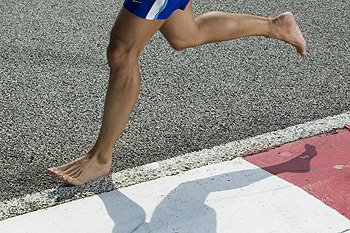 Some people who run barefoot feel like wearing shoes hamper their natural stride and can even cause pain. The heels strike the ground first for runners who wear shoes. This may produce a force of up to three times the body’s weight, which can lead to stress fractures and discomfort. Running barefoot generally causes the runner to land on the ball of the foot, generating less impact on the body. One advantage that barefoot runners have are shortened strides. This reduces the impact on their lower bodies. Because of this, landing becomes softer on hard surfaces. The feet may also be over-supported in running shoes. This may result in weaker muscles, because they’re not working as hard. While barefoot running may be acceptable for some, it is not for everybody. Consult with a podiatrist before you decide to try this form of exercise.
Some people who run barefoot feel like wearing shoes hamper their natural stride and can even cause pain. The heels strike the ground first for runners who wear shoes. This may produce a force of up to three times the body’s weight, which can lead to stress fractures and discomfort. Running barefoot generally causes the runner to land on the ball of the foot, generating less impact on the body. One advantage that barefoot runners have are shortened strides. This reduces the impact on their lower bodies. Because of this, landing becomes softer on hard surfaces. The feet may also be over-supported in running shoes. This may result in weaker muscles, because they’re not working as hard. While barefoot running may be acceptable for some, it is not for everybody. Consult with a podiatrist before you decide to try this form of exercise.
Barefoot running has its own share of benefits and disadvantages. If you have any concerns about your feet or ankles, contact one of our podiatrists from Westside Podiatry Center, LLP. Our doctors will treat your foot and ankle needs.
Barefoot Running
The Impact of Barefoot Running
- Running without shoes changes the motion of your running, as most running is done by landing on the heel of the feet.
- Running barefoot requires a different way of running; the landing is done on the front part of the feet.
The Advantages of Barefoot Running
- When running and landing on the front feet, the impact on the feet and ankle is reduced; this can reduce stress injuries.
- It strengthens muscles in the feet, ankles and lower legs.
- Balance of the body is improved, and there is a greater sensory input from the feet to the rest of the body.
The Drawbacks of Barefoot Running
- No protection while running, makes it likely that runners will land on sharp objects and scrapes, bruises and cuts on the feet will result.
- Blisters may form.
- Possibility of plantar fascia problems.
- Risk of getting Achilles tendonitis.
So, what can runners do to make barefoot running safe? It’s best to make a slow transition from running shoes to barefoot running. Once the feet begin to adjust, try walking, then jogging and gradually increasing the distance. Minimalist running shoes may also be an option.
If you have any questions please feel free to contact one of one of our offices located in Liverpool, Camillus, Skaneateles, Oswego, and Cicero, NY . We offer the newest diagnostic and treatment technologies for all your foot and ankle needs.
Read more about Barefoot RunningBunions and How They are Treated
 A bunion is a deformity that occurs on the joint at the base of the big toe. Though the exact cause of bunions is somewhat disputed, wearing tight fitting shoes and genetics tend to play a role in the development and exacerbation of them. Common symptoms that are usually associated with bunions include swelling, soreness, pain, and redness around the joint and bump. Bunions can become worse over time, and poorly-supportive footwear, like high heels, have been associated with worsening them. It is recommended to see a podiatrist when you notice a bunion forming even when it does not cause pain. If you have a bunion that is causing you pain, you should see one right away. A podiatrist will generally offer non-surgical options first if the bunion is not severe. These include bunion pads to relieve pressure off the bunion, pain and anti-inflammatory medication, and suggesting roomier shoes. If the pain continues or worsens and all non-surgical options have failed, surgery may be considered.
A bunion is a deformity that occurs on the joint at the base of the big toe. Though the exact cause of bunions is somewhat disputed, wearing tight fitting shoes and genetics tend to play a role in the development and exacerbation of them. Common symptoms that are usually associated with bunions include swelling, soreness, pain, and redness around the joint and bump. Bunions can become worse over time, and poorly-supportive footwear, like high heels, have been associated with worsening them. It is recommended to see a podiatrist when you notice a bunion forming even when it does not cause pain. If you have a bunion that is causing you pain, you should see one right away. A podiatrist will generally offer non-surgical options first if the bunion is not severe. These include bunion pads to relieve pressure off the bunion, pain and anti-inflammatory medication, and suggesting roomier shoes. If the pain continues or worsens and all non-surgical options have failed, surgery may be considered.
If you are suffering from bunions, contact one of our podiatrists of Westside Podiatry Center, LLP. Our doctors can provide the care you need to keep you pain-free and on your feet.
What Is a Bunion?
A bunion is formed of swollen tissue or an enlargement of boney growth, usually located at the base joint of the toe that connects to the foot. The swelling occurs due to the bones in the big toe shifting inward, which impacts the other toes of the foot. This causes the area around the base of the big toe to become inflamed and painful.
Why Do Bunions Form?
Genetics – Susceptibility to bunions are often hereditary
Stress on the feet – Poorly fitted and uncomfortable footwear that places stress on feet, such as heels, can worsen existing bunions
How Are Bunions Diagnosed?
Doctors often perform two tests – blood tests and x-rays – when trying to diagnose bunions, especially in the early stages of development. Blood tests help determine if the foot pain is being caused by something else, such as arthritis, while x-rays provide a clear picture of your bone structure to your doctor.
How Are Bunions Treated?
- Refrain from wearing heels or similar shoes that cause discomfort
- Select wider shoes that can provide more comfort and reduce pain
- Anti-inflammatory and pain management drugs
- Orthotics or foot inserts
- Surgery
If you have any questions, please feel free to contact one of our offices located in Liverpool, Camillus, Skaneateles, Oswego, and Cicero, NY . We offer the newest diagnostic and treatment technologies for all your foot care needs.
Read more about BunionsMore...
How to Prevent Falls Among the Elderly
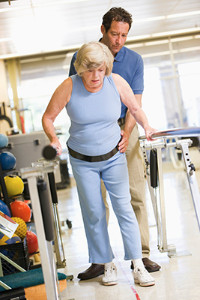 Elderly Americans are at an increased risk of falling than younger Americans. Falls are a leading cause of injury among the elderly, therefore it is important for older persons to know how to prevent them in the first place. Staying active through exercising is an excellent way to stay flexible, mobile, and strong. There are exercise groups all over the country that help older people stay in shape. Make sure to clear any debris from the floor that can make tripping more likely. Lighting is another important aspect in preventing falls in the home. Installing night lights that turn on automatically in and near the restroom can help prevent falls during late-night bathroom trips. Going to routine check-ups with a doctor is advised as well, and it is important to ask if any prescribed medications can cause drowsiness or lightheadedness. Finally, have one’s eyes and hearing checked regularly to help maintain alertness. Falls pose a unique risk to older citizens, and knowing how to prevent them can make all the difference.
Elderly Americans are at an increased risk of falling than younger Americans. Falls are a leading cause of injury among the elderly, therefore it is important for older persons to know how to prevent them in the first place. Staying active through exercising is an excellent way to stay flexible, mobile, and strong. There are exercise groups all over the country that help older people stay in shape. Make sure to clear any debris from the floor that can make tripping more likely. Lighting is another important aspect in preventing falls in the home. Installing night lights that turn on automatically in and near the restroom can help prevent falls during late-night bathroom trips. Going to routine check-ups with a doctor is advised as well, and it is important to ask if any prescribed medications can cause drowsiness or lightheadedness. Finally, have one’s eyes and hearing checked regularly to help maintain alertness. Falls pose a unique risk to older citizens, and knowing how to prevent them can make all the difference.
Preventing falls among the elderly is very important. If you are older and have fallen or fear that you are prone to falling, consult with one of our podiatrists from Westside Podiatry Center, LLP. Our doctors will assess your condition and provide you with quality advice and care.
Every 11 seconds, an elderly American is being treated in an emergency room for a fall related injury. Falls are the leading cause of head and hip injuries for those 65 and older. Due to decreases in strength, balance, senses, and lack of awareness, elderly persons are very susceptible to falling. Thankfully, there are a number of things older persons can do to prevent falls.
How to Prevent Falls
Some effective methods that older persons can do to prevent falls include:
- Enrolling in strength and balance exercise program to increase balance and strength
- Periodically having your sight and hearing checked
- Discuss any medications you have with a doctor to see if it increases the risk of falling
- Clearing the house of falling hazards and installing devices like grab bars and railings
- Utilizing a walker or cane
- Wearing shoes that provide good support and cushioning
- Talking to family members about falling and increasing awareness
Falling can be a traumatic and embarrassing experience for elderly persons; this can make them less willing to leave the house, and less willing to talk to someone about their fears of falling. Doing such things, however, will increase the likelihood of tripping or losing one’s balance. Knowing the causes of falling and how to prevent them is the best way to mitigate the risk of serious injury.
If you have any questions, please feel free to contact one of our offices located in Liverpool, Camillus, Skaneateles, Oswego, and Cicero, NY . We offer the newest diagnostic and treatment technologies for all your foot care needs.
Read more about Falls PreventionWashington Wizards Guard Tears Achilles Tendon
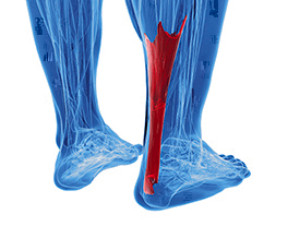 Basketball player Sheldon Mac of the Wizards has recently torn his left Achilles tendon and will need to undergo surgery to repair it. He will very likely be out for the rest of the season. His recovery timetable is around six to eight months. If there is any good news for Mac, it's that his contract guarantees him 1.3 million dollars. Of course, that doesn't really give much solace to the fans.
Basketball player Sheldon Mac of the Wizards has recently torn his left Achilles tendon and will need to undergo surgery to repair it. He will very likely be out for the rest of the season. His recovery timetable is around six to eight months. If there is any good news for Mac, it's that his contract guarantees him 1.3 million dollars. Of course, that doesn't really give much solace to the fans.
Achilles tendon injuries need immediate attention to avoid future complications. If you have any concerns, contact one of our podiatrists of Westside Podiatry Center, LLP. Our doctors can provide the care you need to keep you pain-free and on your feet.
What Is the Achilles Tendon?
The Achilles tendon is a tendon that connects the lower leg muscles and calf to the heel of the foot. It is the strongest tendon in the human body and is essential for making movement possible. Because this tendon is such an integral part of the body, any injuries to it can create immense difficulties and should immediately be presented to a doctor.
What Are the Symptoms of an Achilles Tendon Injury?
There are various types of injuries that can affect the Achilles tendon. The two most common injuries are Achilles tendinitis and ruptures of the tendon.
Achilles Tendinitis Symptoms
- Inflammation
- Dull to severe pain
- Increased blood flow to the tendon
- Thickening of the tendon
Rupture Symptoms
- Extreme pain and swelling in the foot
- Total immobility
Treatment and Prevention
Achilles tendon injuries are diagnosed by a thorough physical evaluation, which can include an MRI. Treatment involves rest, physical therapy, and in some cases, surgery. However, various preventative measures can be taken to avoid these injuries, such as:
- Thorough stretching of the tendon before and after exercise
- Strengthening exercises like calf raises, squats, leg curls, leg extensions, leg raises, lunges, and leg presses
If you have any questions please feel free to contact one of our offices located in Liverpool, Camillus, Skaneateles, Oswego, and Cicero, NY . We offer the newest diagnostic tools and technology to treat your foot and ankle needs.
Read more about What are Achilles Tendon InjuriesWildcats Point Guard Rawle Alkins Undergoes Foot Surgery
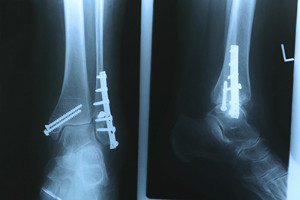 Sophomore Rawle Alkins of the University of Arizona Wildcats is expected to miss 8 to 12 weeks due to surgery on a recent fracture in his right foot. Alkins sustained the injury during voluntary activities with teammates. The surgery was reported to be a success, and Alkins is now recovering. Alkins was the third leading scorer on the Wildcats one season ago, and his absence will be missed.
Sophomore Rawle Alkins of the University of Arizona Wildcats is expected to miss 8 to 12 weeks due to surgery on a recent fracture in his right foot. Alkins sustained the injury during voluntary activities with teammates. The surgery was reported to be a success, and Alkins is now recovering. Alkins was the third leading scorer on the Wildcats one season ago, and his absence will be missed.
Foot surgery is sometimes necessary to treat a foot ailment. To learn more, contact one of our podiatrists of Westside Podiatry Center, LLP. Our doctors will assist you with all of your foot and ankle needs.
When Is Surgery Necessary?
Foot and ankle surgery is generally reserved for cases in which less invasive, conservative procedures have failed to alleviate the problem. Some of the cases in which surgery may be necessary include:
- Removing foot deformities like bunions and bone spurs
- Severe arthritis that has caused bone issues
- Cosmetic reconstruction
What Types of Surgery Are There?
The type of surgery you receive will depend on the nature of the problem you have. Some of the possible surgeries include:
- Bunionectomy for painful bunions
- Surgical fusion for realignment of bones
- Neuropathy decompression surgery to treat nerve damage
Benefits of Surgery
Although surgery is usually a last resort, it can provide more complete pain relief compared to non-surgical methods and may allow you to finally resume full activity.
Surgical techniques have also become increasingly sophisticated. Techniques like endoscopic surgery allow for smaller incisions and faster recovery times.
If you have any questions please feel free to contact one of our offices located in Liverpool, Camillus, Skaneateles, Oswego, and Cicero, NY . We offer the newest diagnostic and treatment technologies for all your foot and ankle needs.
Read more about Sports Related Foot And Ankle InjuriesHow to Take Good Care of Your Aging Feet
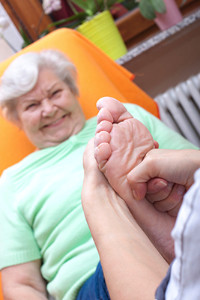 Taking care of your feet is instrumental in preventing potential injury, especially as you get older. The following are some tips on how to properly care for your feet. It's common among the elderly to suffer from both dry skin and fungal infections, especially toenail fungus. To tackle dry skin, wash your feet in warm water, dry thoroughly, and then apply moisturizer. Toenail fungus can be a burden to eliminate, so it's recommended to see a podiatrist for treatment. Choosing the right footwear can mean the difference between comfort and injury. Avoid uncomfortable and unsupportive footwear such as heels, flats, or sandals. Instead, opt for athletic shoes as these offer more support, comfort, and protection. Always ensure that new shoes fit well and provide enough toe room. Orthotics are recommended for those with flat feet or those who need a better insole. Finally, perform routine foot checks for any abnormalities or damage.
Taking care of your feet is instrumental in preventing potential injury, especially as you get older. The following are some tips on how to properly care for your feet. It's common among the elderly to suffer from both dry skin and fungal infections, especially toenail fungus. To tackle dry skin, wash your feet in warm water, dry thoroughly, and then apply moisturizer. Toenail fungus can be a burden to eliminate, so it's recommended to see a podiatrist for treatment. Choosing the right footwear can mean the difference between comfort and injury. Avoid uncomfortable and unsupportive footwear such as heels, flats, or sandals. Instead, opt for athletic shoes as these offer more support, comfort, and protection. Always ensure that new shoes fit well and provide enough toe room. Orthotics are recommended for those with flat feet or those who need a better insole. Finally, perform routine foot checks for any abnormalities or damage.
Proper foot care is something many older adults forget to consider. If you have any concerns about your feet and ankles, contact one of our podiatrists from Westside Podiatry Center, LLP. Our doctors can provide the care you need to keep you pain-free and on your feet.
The Elderly and Their Feet
As we age we start to notice many changes in our body, but the elder population may not notice them right away. Medical conditions may prevent the elderly to take notice of their foot health right away. Poor vision is a lead contributor to not taking action for the elderly.
Common Conditions
- Neuropathy – can reduce feeling in the feet and can hide many life-threatening medical conditions.
- Reduced flexibility – prevents the ability of proper toenail trimming, and foot cleaning. If left untreated, it may lead to further medical issues.
- Foot sores – amongst the older population can be serious before they are discovered. Some of the problematic conditions they may face are:
- Gouging toenails affecting nearby toe
- Shoes that don’t fit properly
- Pressure sores
- Loss of circulation in legs & feet
- Edema & swelling of feet and ankles
Susceptible Infections
Diabetes and poor circulation can cause general loss of sensitivity over the years, turning a simple cut into a serious issue.
If you have any questions please feel free to contact one of our offices located in Liverpool, Camillus, Skaneateles, Oswego, and Cicero, NY . We offer the newest diagnostic and treatment technologies for all your foot and ankle needs.
Read more about Elderly and their Feet
